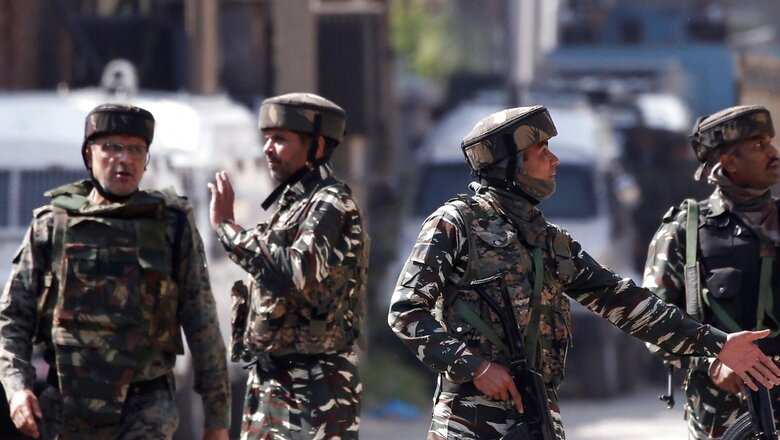
views
Mooted as a step that would save crores annually on defence pensions, the draft of the Tour of Duty scheme has proposed to recruit soldiers on three and five-year contracts. There has been no formal announcement on the scheme from the government, though it is expected that the scheme will first take off with the Army and then extend to the Navy and the Indian Air Force.
As the plan stands now, 50 per cent of Army soldiers will retire from service within five years, while the rest will continue till the standard retirement age of the soldiers. It is understood that internal deliberations are still ongoing within the Army, with most arms batting for a bigger percentage of permanent soldiers.
Triggered by media reports of its possible announcement, the debate has assumed a greater significance with the recruitment of soldiers continuing to remain suspended for two years now. It has also given way to questions on whether this would be the only mode under which soldiers will be recruited once the process resumes.
But beyond everything else, the first question which occurs to me is why should there be any takers for the scheme in the first place?
Much of India’s youth, particularly from the rural belts of the country, are keen to join the defence forces and consider it a lucrative job as well. Apart from the patriotism factor, there are three reasons for them to take up the job, which is fraught with risks, including getting killed in action.
This includes a permanent government job, a life-long pension, and the status and respect which comes with a job in the Army.
The Tour of Duty offers none of these.
So if the government decides to go ahead with the scheme which is set to affect thousands, the defence establishment needs to first offer clarity on the perks which can come with a job that is temporary.
Can lead to a plethora of court cases
Many of those aware of the details of the scheme say the biggest advantage of it would be to save on the ballooning defence pensions, which can be pumped back for modernisation of the Indian Armed Forces.
The overall defence budget for 2022-23 is Rs 5.25 lakh crore, of which Rs 1.19 lakh crore has been earmarked for pensions.
Some others feel that in the absence of a psychological test for soldiers like in the Services Selection Board (SSB) examination for officers, this scheme would go some way in weeding out non-efficient personnel and keeping a crop of trained, competitive and motivated soldiers in the service.
Those aware of the details of the scheme say various options are being worked out to make the scheme more attractive, such as various medical benefits applicable to Armed Forces veterans and provisions to ensure a preference in government jobs for those retiring earlier. Additionally, it is imperative that options for their lateral absorption in government departments or security forces be actively considered.
But there are other issues too, beyond doubts in the military circles over what a part-time soldier would mean to the Army.
As of now, Army soldiers are assessed on their firing capabilities and physical fitness. Annual Confidential Reports for their career progression are only initiated once they reach the rank of Naik in eight to 12 years of service. The promotion to the rank of Naik is based on a promotion cadre, a training programme.
For the first five to six years after induction into the Army, all general duty soldiers perform similar tasks. Framing a set of well-defined criteria to select the 50 per cent of soldiers who would make the cut to the permanent lot may pose a big challenge.
And in the absence of that, the Armed Forces and the government would end up fighting a plethora of court cases, which would drain attention and resources.
Another factor to consider here is how receptive will infantry and other fighting arms and even Rashtriya Rifles units engaged in counterterrorism duties be to conduct operations with ToD soldiers? Can this be done without blunting the operational edge of the Army or will they be inducted only for support arms? Those in the know of things tell me that most of these issues are yet to be resolved.
Improving tooth-to-tail ratio of Army needs more attention
ToD may be a radical scheme to cut down on defence pensions, but what deserves to be at the centre stage is enhancing the Army’s tooth-to-tail ratio.
This would mean making the Army a leaner entity with a greater focus on enhancing its combat capabilities and lesser on support elements while maintaining the requisite balance between the two.
An increased amount of dual trade training of all Army personnel to cut short the repair and maintenance chains and an integration of logistics with local resources and civil infrastructure are among the ways that can be adopted towards this effort.
An overall reduction of Army personnel and an increased reliance on technology is an oft-discussed measure towards improving the efficiency of the force.
There is already a shortage of 1.1 lakh soldiers in the Army at present with the suspension of recruitment rallies in the last two years. This is increasing by about 5,000 troops every month.
So, while ToD may fill up part of this gap in the next few years, it does little to address this key area of improvement in the Army.
Read all the Latest News India and Breaking News here


















Comments
0 comment